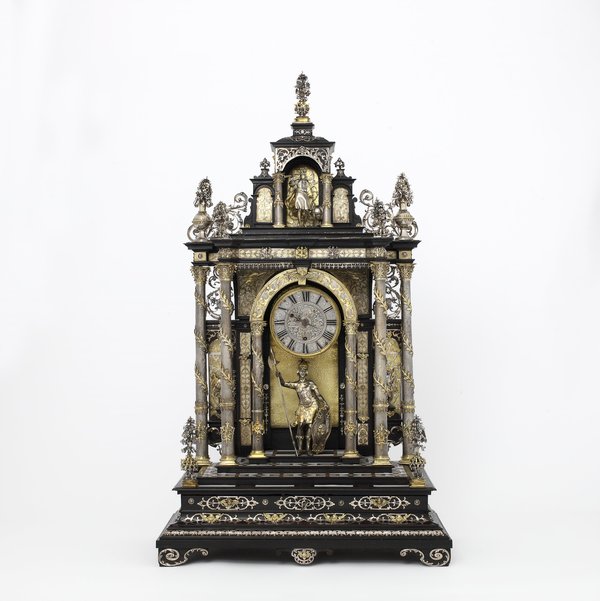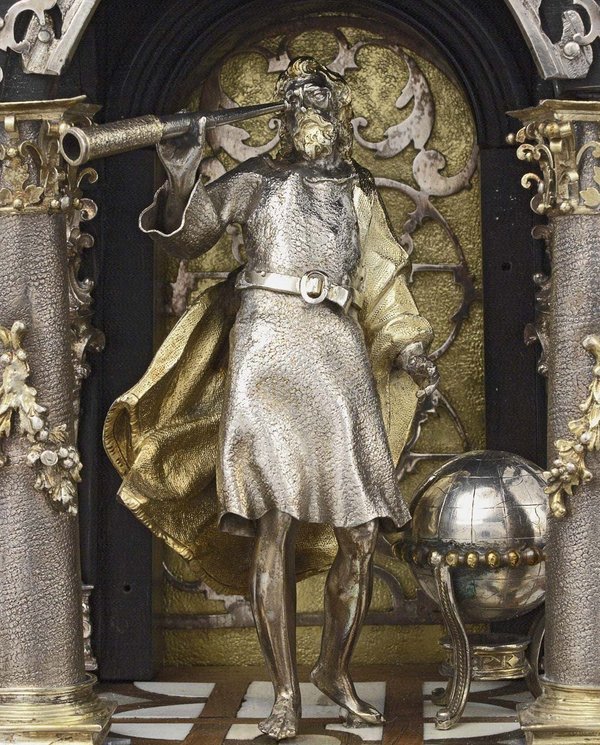Christ transformed into an astronomer
This post was written by Peter de Clercq
As I have a special interest in historical scientific instruments, I was intrigued when I first saw this clock some twenty years ago in Somerset House in central London, overlooking the River Thames.
As far as I remember, the exhibition label did not comment on the figure of a man looking through a telescope, with a pair of dividers in his left hand and a globe at his feet. I was intrigued. The first telescope was developed in 1608. Could this be a very early representation of such an instrument in use?

Sir Arthur Gilbert and his wife Rosalinde formed one of the world's great decorative art collections, which he donated to Britain in 1996. Parts of it were on display in Somerset House from 2002 to 2008. After that, the collection was transferred on loan to the Victoria and Albert Museum, where a generous selection is on display in Gallery 70.
And here I saw the clock again, and learned something I had failed to understand when I first saw it.
The silver-gilt, ebony and ivory clock of architectural form, 76.5 cm high, is a combination of a shrine and a table clock, both made in the seventeenth century but assembled into the current configuration in the late nineteenth century, probably in Berlin. The clock is signed on the dial and the backplate by Elias Kreittmayer (1639–1697), a clockmaker working in Friedberg in Germany, while the shrine is ascribed to the Augsburg goldsmith Matthias Walbaum (1554–1632).
As the gallery label states ‘Made to appeal to specialist collectors, the shrine’s original Christian nature can still be seen in the figure with a telescope (above the dial), who was adapted from a representation of Christ. Such transformations are masterpieces in their own right.’
So the miniature telescope was not as old as I had thought.

There is a sobering story connected to the clock. One of its previous owners was Nathan Ruben Fränkel (1848–1909), a Jewish clockmaker from Frankfurt who built up an encyclopaedic collection of timepieces. It is not known what happened to this clock after his death and in the years before it resurfaced in 1975. And this uncertainty is alarming because of the extent of persecution experienced by his family.
Friedrich and Klara Fränkel, who ran a thriving watch business in Frankfurt, were forced into bankruptcy by the Nazis. In 1938, they fled to France where they narrowly escaped deportation and survived the war in hiding.
The clock has formed part of a special provenance display in the V&A 'Concealed Histories: Uncovering the Story of Nazi Looting' (December 2019–June 2021).

Let’s end on a more uplifting note.
In 1890, the German clock collector Carl Marfels (1854–1929) presented the clock in the Deutsche Uhrmacher-Zeitung, the journal for clock- and watchmakers. His article is illustrated with a photo on which the telescope and the globe can clearly be seen. Marfels does not seem to have realised that the object had been doctored with. He concludes: ‘[…] the clock is yet another proof of the high standard of clockmaking in Augsburg in the 16th and 17th centuries’.
If it were indeed original, the clock would have contained a very early representation of a telescope — but we now know better.
A version of this blog post was published in the Bulletin of the Scientific Instrument Society, No 160 (March 2024), p. 19.